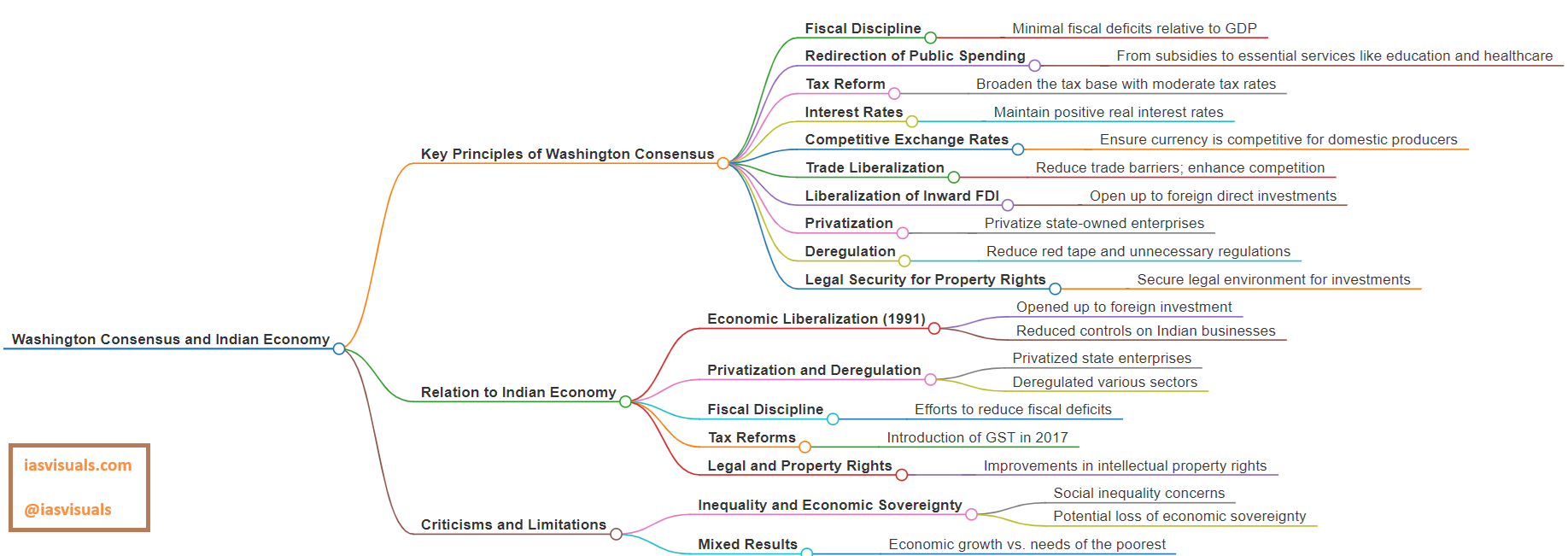The Washington Consensus refers to a set of ten economic policy prescriptions considered to constitute the “standard” reform package promoted for crisis-wracked developing countries by Washington, D.C.-based institutions such as the International Monetary Fund (IMF), World Bank, and the US Treasury Department. These principles broadly emphasize macroeconomic stabilization, economic opening with respect to both trade and investment, and the expansion of market forces within the domestic economy.
Key Principles of the Washington Consensus
The original Washington Consensus specifically included policies such as:
1. Fiscal Discipline – Avoiding large fiscal deficits relative to GDP.
2. Redirection of Public Spending – From subsidies toward broad-based services like primary education, primary health care, and infrastructure investment.
3. Tax Reform – Broadening the tax base and adopting moderate marginal tax rates.
4. Interest Rates – Keeping interest rates positive in real terms to encourage savings and investment.
5. Competitive Exchange Rates – Ensuring the currency is competitive to help domestic producers in world markets.
6. Trade Liberalization – Removing trade barriers and encouraging competition.
7. Liberalization of Inward Foreign Direct Investment – Eliminating restrictions on foreign direct investments.
8. Privatization – Privatizing state enterprises.
9. Deregulation – Reducing red tape and unnecessary regulations that hinder business and market entry.
10. Legal Security for Property Rights – Ensuring legal security for both domestic and foreign investors.
Relation to the Indian Economy
While the Washington Consensus itself was never formally adopted as a policy package in India, many of its elements resonate with reforms that India has implemented, especially post the economic crisis of 1991. Here’s how some of these principles have played out in India:
1. Liberalization of the Economy: Starting in 1991, under the leadership of then Finance Minister Dr. Manmohan Singh, India initiated a series of structural reforms that included opening up to foreign investment and reducing controls on Indian business. This aligns with the Washington Consensus principles regarding trade liberalization and attracting foreign direct investment.
2. Privatization and Deregulation: Throughout the 1990s and 2000s, India gradually privatized a number of state-owned enterprises and deregulated various sectors of the economy, which reflects the Washington Consensus’ emphasis on privatization and deregulation.
3. Fiscal Discipline: India has made various efforts to maintain fiscal discipline, though with varying degrees of success. Policies have focused on reducing the fiscal deficit and controlling inflation, which are in line with the Washington Consensus’ principles.
4. Tax Reforms: Reforms in the tax system, including the introduction of Goods and Services Tax (GST) in 2017, aimed to create a unified tax market and to broaden the tax base, which is a recommendation of the Washington Consensus.
5. Legal and Property Rights: Improvements in legal frameworks for protecting property rights and investments have been slower, but progress has been made, particularly in terms of intellectual property rights and legal processes.
Criticisms and Limitations
The application and impact of Washington Consensus policies have been subjects of considerable debate. Critics argue that these policies often result in social inequality and could lead to a loss of economic sovereignty. In India, these reforms have been both praised for spurring economic growth and criticized for leading to increased inequality and not adequately addressing the needs of the poorest.
In summary, while the Washington Consensus has not been explicitly adopted by India, many of its elements can be seen in the economic reforms that India has pursued over the past few decades. These reforms have contributed to India’s growth into one of the world’s largest economies, although challenges remain.

